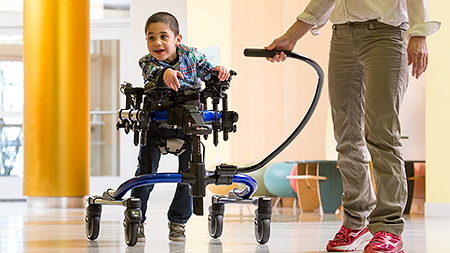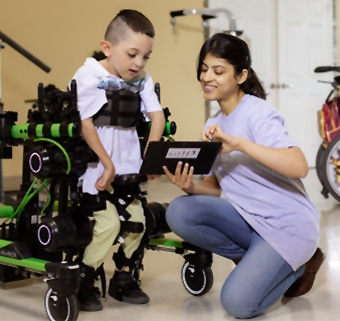Gait Training and Dynamic Movement
What we think about when we think about good gait pattern.
| July 2016 Building off the foundational concepts of neuroplasticity and motor learning, clinical gait training is an advancing intervention. With the aim to provide independence in gait and a full recovery for those with developmental or acquired disabilities, this discipline continues to incorporate new research and approaches into existing intervention protocols.
Building off the foundational concepts of neuroplasticity and motor learning, clinical gait training is an advancing intervention. With the aim to provide independence in gait and a full recovery for those with developmental or acquired disabilities, this discipline continues to incorporate new research and approaches into existing intervention protocols.
In the last few years we’ve seen increased interest in the notion of dynamic gait training. The term “dynamic” is appropriate because it describes gait training that facilitates natural body movement, weight-shifting and stepping and follows the recommended clinical progression. And research tells us that when gait intervention is dynamic there are better outcomes and improvements in physiological gait pattern.
Typically, dynamic intervention is facilitated through the use of adaptive equipment. When we think of the term dynamic in regards to therapy, it brings to mind equipment that has both functional positioning options and the built-in capacity to move, bounce or flex when acted upon by the client. Indeed, the word dynamic suggests change and movement.
The History
The shift towards using dynamic movement and equipment in rehabilitation actually began in 2001 when the World Health Organization first introduced the ICF (International Classification of Functioning, Disability and Health) framework, which has since become the gold standard for all therapy intervention. Because the ICF recognizes the potential for people with disabilities to engage in activities and participate in society despite their disabilities, intervention within this framework aims to improve functional mobility often through the use of adaptive equipment. But not just any equipment will do. The ICF created a demand for equipment that facilitates function and participation - dynamic adaptive positioning equipment providing flexibility and movement opportunities for the client.
 Manufacturers responded to this demand. For example, in gait devices alone we now have the Kidwalk- a dynamic gait trainer with three planes of movement to encourage typical walking patterns, the Lokomat Pro with FreeD module allowing for lateral weight shift and rotation of the pelvis, and the Rifton Dynamic Pacer gait trainer with lateral and vertical movement plus dynamic body weight support.
Manufacturers responded to this demand. For example, in gait devices alone we now have the Kidwalk- a dynamic gait trainer with three planes of movement to encourage typical walking patterns, the Lokomat Pro with FreeD module allowing for lateral weight shift and rotation of the pelvis, and the Rifton Dynamic Pacer gait trainer with lateral and vertical movement plus dynamic body weight support.
Preliminary Evidence
No intervention is completely acceptable unless it is supported by the research. And with dynamic positioning and mobility interventions the preliminary evidence is certainly positive. Take for instance the studies by both Hahn and Cimolin looking at a dynamic seating intervention for children with neuromuscular dysfunction. The dynamic seating interventions in this case were wheelchairs that allowed the child to extend at the hips and knees. Both studies had similar results. The kids using the dynamic configuration showed improvement in range of motion, sitting and standing skills, and decreases in spasticity compared to their static counterparts (Hahn 2009, Cimolin 2009). These two studies lead researchers Paleg and Livingstone to make their observation that “Research on dynamic seating suggests that dynamic gait trainers may be beneficial for children with spasticity and dystonia.” (Paleg 2015).
Paleg’s prediction is bearing out. We are beginning to see that when dynamic gait trainers are used for people with disabilities there is a trend towards more fluid, energy efficient walking. That is most likely because dynamic gait trainers accommodate the natural movements of the body during gait (Low 2009, Frey 2006).
Why Is Gait Dynamic?
When people walk there are subtle shifts in the body from side to side and up and down. This must happen for step taking to occur. In the vertical direction, the center of gravity (located in the pelvis) moves up and down to follow a smooth sinusoidal path. The lowest point of this path occurs when the foot initially hits the ground and the highest point occurs at mid-stance to help clear the contralateral swing leg as it moves through to take a step. The average vertical displacement of the center of gravity during stepping is roughly five centimeters. This up and down motion also contributes to the body’s ability to store and release energy for efficiency and highest performance levels.
Lateral displacement of the center of gravity also follows a smooth sinusoidal curve with an average displacement of two inches. In gait this is referred to as weight-shifting. During the stance phase of gait the center of gravity moves laterally towards the planted limb making it easier to swing the contralateral limb through to take a step.
So when talking about dynamic gait systems we are essentially focusing on the device’s ability to accommodate the movement of the center of gravity (pelvis) since restricting the movement of the pelvis hampers the naturally occurring mechanics of step-taking. Ted Pastrick, a physical therapist from Los Angeles Unified School District notes that “walking is a three-dimensional activity with pitch, roll and yaw acting in concert at the pelvis. A dynamic gait trainer allows for this free movement during gait whereas [static] models provided only stability and support. This added mobility at the pelvis provides a wonderful opportunity for the user to experience a more natural gait.”
 Additionally, there is the concept of body-weight support (BWS) during gait. In a static system, the straps of the pelvic support are set to a fixed length. During ambulation as a patient raises and lowers their body as in stepping, the straps alternately go from slack to taut. The constancy of body-weight unloading is not guaranteed and this negatively affects gait pattern by issuing destabilizing forces to the patient (Hidler 2011).
Additionally, there is the concept of body-weight support (BWS) during gait. In a static system, the straps of the pelvic support are set to a fixed length. During ambulation as a patient raises and lowers their body as in stepping, the straps alternately go from slack to taut. The constancy of body-weight unloading is not guaranteed and this negatively affects gait pattern by issuing destabilizing forces to the patient (Hidler 2011).
In a dynamic system however, the amount of vertical unloading is kept constant while still allowing the center of gravity to move through its curve. Research shows that dynamic BWS creates more natural ground-reaction forces and gait characteristics (Frey 2006, Hidler 2011).
Observations from the Field
All of this is confirmed by professionals working with clients previously in static BWS devices who had the opportunity to switch to dynamic BWS gait devices. As noted by therapist Barbara Waldron, “Dynamic body-weight support improved the gait of my clients right away. ” And therapist Bill Lynch who writes, “The dynamic body-weight seat allowed enough natural gait and rhythmic motion that significant changes in walking patterns were noticed immediately.”
From this it’s clear that dynamic gait devices are valuable tools in the rehab setting. When someone has a neurological injury or disability there is resulting weakness, dystonia, balance and motor planning issues which all affect gait performance. Through clinical gait training that follows the principles of motor learning and neuroplasticity we see partial to complete recovery of the lost function. Stated plainly, in a dynamic gait system people simply walk well and progress quicker because the human body is dynamic and designed to move.
References
Hahn M, Simkins S, Gardner J, et al. A dynamic seating system for children with cerebral palsy. J Musculoskeletal Research. 2009; 12 (1): 21-30.
Cimolin V, Piccinini L, Avellis M, et al. 3D-quantitative evaluation of a rigid seating system and dynamic seating system using 3D movment analysis in individuals with dystonic tetraparesis. Disabil Rehabil Assist Technol. 2009; 4(6):422-28.
Paleg G, Livingstone R. Outcomes of gait trainer use in home and school settings for children with motor impairments: A systematic review. Clin Rehabil. 2015; January 30. [Epub ahead of print].
Low S, Westcott S. A comparison of two support walkers on the gait parameters of children with cerebral palsy- abstract. Dev Med Child Neurol. 2009;51:62.
Frey M, Colombo G, Vaglio M, Bucher R, Jorg M, Riener R. A novel mechatronic body weight support system. IEEE Trans Neural Syst Rehabil Eng. 2006;14(3):311-21.
Hidler J, Brennan B, Black I, Nichols D, Brady K, Nef T. ZeroG: Overground gait and balance training system. J Rehabil Res Dev. 2011;48(4): 287-98.




